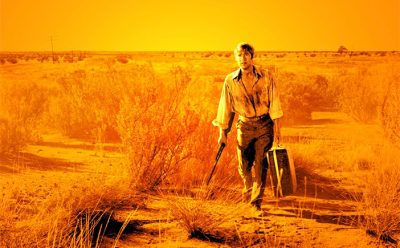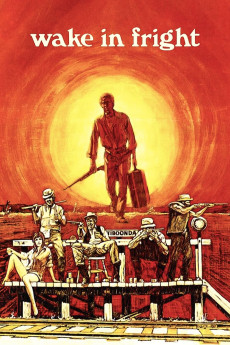Australia’s Cinema: To Wake in Fright

What is inescapable in the Australian landscape is its cosmic character, one that mixes suggestively astral dust with the brilliance of the blinding sun. Desolate, parched earth becomes poetic affirmation, though it is the poetry of death and distraction, its stanzas luring the life from you.
Ted Kotcheff’s Wake in Fright (1971), based on the Kenneth Cook novel of the same name, still retains that grim sense of the life that is drawn out in such spaces, and left to expire, slowly. Its importance has been given another airing this year with the efforts of Australian film critic David Stratton in Stories of Australian Cinema.
The characters, liberated from ties of urbanised civility, go about living as the days were their last. The tussle between Eros and Thanatos is ever present, and the god of death certainly gets a good run for his money.

Wake in Fright, 1971 (Source: YTS)
Themes of servitude abound, perhaps unsurprising given that Australia was itself a conception of prison, its colonisation inflicting the cruelty of civilisation upon prior inhabitants, not to mention its own prison population. Settler societies never expel the echo of cruelty that governs character and existence.
John Grant, the school teacher played by a trim, sharply dressed Gary Bond, speaks of his bondage to the Education Department, his condemnation to work more or less as an indentured teacher in a two-building town called Tiboonda. There are the students; there is the cranky bar man. And there is the vast expanse.
The teaching period ends. Grant dreams of a holiday filled with beach sand and purifying sea. Sydney and a girlfriend beckon. But before that, he needs to get to Bundanyabba (“The Yabba”), a mining town that echoes Broken Hill. From there, the metropolis beckons.
Grant meets a superbly sinister policeman played by Chips Rafferty and is assured that the town is a delight, with few suicides. But things go terribly wrong, and he finds himself broke after losing in a game of two-up.
There is a simplistic, instinct driven barbarism in Kotcheff’s realised Outback: the game of two-up, played by the roughly attired, those sodden in sweat, beer and smoke pouring through mouths like chimney stacks, draws Grant in. A game that involves a toss, a heads or tails outcome, is hardly going to tax the cerebral. But here, away from the calming hand of reflection, fortunes can be made in the red blood moment. They can also be lost.
Trapped, the Yabba encloses him. He meets Tim Hynes and his daughter Janette. He sponges. He is fed and watered (more the point “beered”). In what is an endlessly alcoholic sequence, miners Dick and Joe, turn up to Hynes’ abode. As does the alcoholic doctor and resident sage, Doc Tydon, played with pungent menace by Donald Pleasence. Then comes the kangaroo hunting.
There is ceremonial worship for fallen comrades in times of war, as if reminding Australians that their distance was no excuse not to give blood to foreign causes. Gamble, play the poker machines, and drink, but do not forget to stand on ceremony when it counts.
Even the local hospitality, as the film notes, is aggressive, direct to the point of being tyrannical. To demand your own views – to refuse a beer that is dashed down with flash flood speed – is to commit something tantamount to treason. Never is the hand allowed to be free of a beer can, a glass, or bottle. The only true hero in this script is, perhaps, the amber fluid.
Such hospitality ultimately turns Grant’s character. Propriety is suspended by a concept of mateship that seeks expression in unshackled violence. He is with gun-toting mates. Spine tingling scenes of the kangaroo hunt brings the Australian cosmic scape into view, which is one of unholy massacre.
There is nothing noble in this confrontation. This is not a mystical confrontation between the hunter and the hunted, with the latter being given at least a sporting chance. This is a spectacle of carnage, and a beastly one at that. Wounded animals are butchered; half carcasses are left in the manner of a Goya sketch on war.
Strikingly, we are left with no moment of empathy, no sense of catharsis. Grant’s crumpled character is far from edifying. He is civilisation’s fragile prop lost in the enormity of the Never Never, and it is unpleasant. He is a participant incapable of maintaining himself, holding the fort as the Yabba locals clamour to break through his defences. Drawn into the nativist trap like Joseph Conrad’s Kurtz, his life darkens. The exits close, and the town keeps drawing him back, draining his mortal reserves.
It was for good reason film critic of the Chicago Sun-Times, Roger Ebert, deemed this effort “powerful, genuinely shocking and rather amazing”. It also left Martin Scorsese “speechless”, though at Cannes, where the film was nominated for the Palme D’Or, he proved effusively enthusiastic. But most amusingly for novelist Peter Temple, in a testament to how celluloid can move, it may well have set back tourism in Australia back twenty years.[1]
Dr. Binoy Kampmark was a Commonwealth Scholar at Selwyn College, Cambridge. He lectures at RMIT University, Melbourne. Email: [email protected].
Note
[1] http://www.newyorker.com/culture/culture-desk/wake-in-fright-prepare-to-be-disturbed-mate
Featured image: Film International

